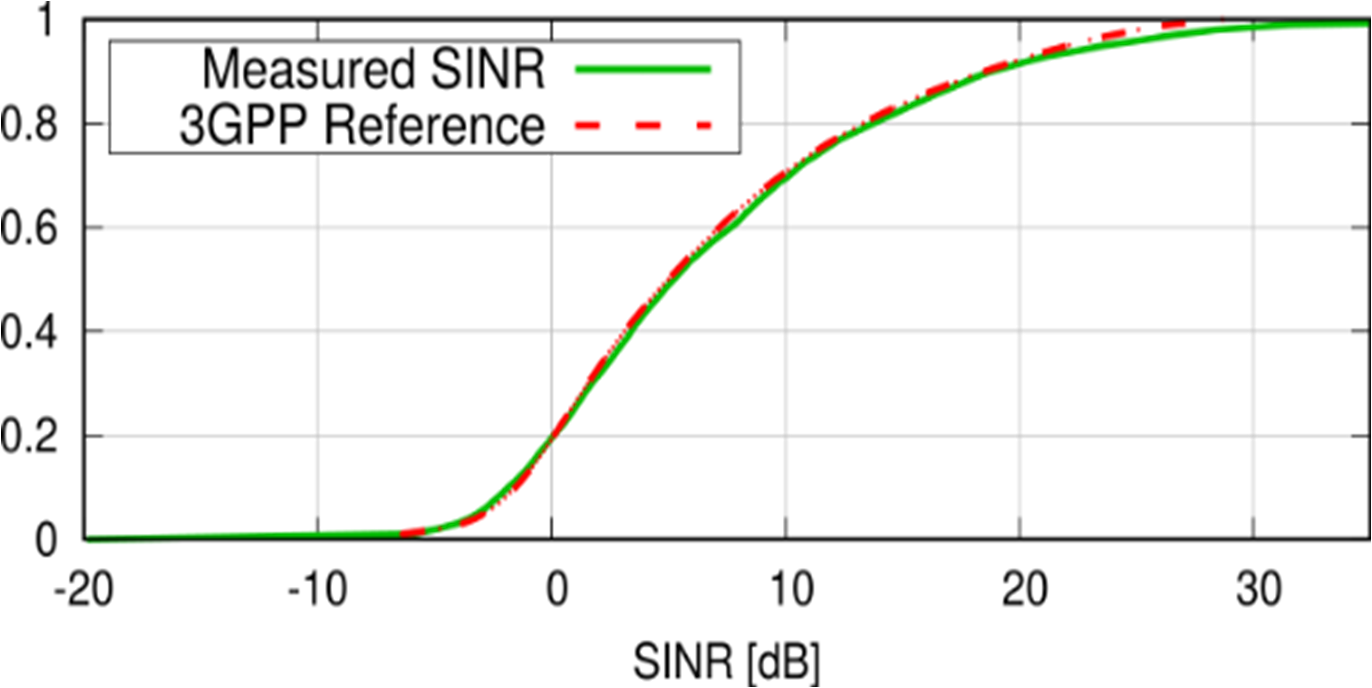Description
Simu5G is a 5G New Radio (NR) simulator based on the well-known SimuLTE library, developed by the same research group and widely used by industry and academia. Simu5G is based on the OMNeT++ simulation framework, and provides a collection of models with well-defined interfaces, which can be instantiated and connected to build arbitrarily complex simulation scenarios. Simu5G incorporates all the models from the INET library, which allows one to simulate generic TCP/IP networks including 5G NR layer-2 interfaces. In particular, Simu5G simulates the data plane of the 5G RAN (rel. 16) and core network. It allows simulation of 5G communications in both Frequency Division Duplexing (FDD) and Time Division Duplexing (TDD) modes, with heterogeneous gNBs (macro, micro, pico etc.), possibly communicating via the X2 interface to support handover and inter-cell interfer-ence coordination. Dual connectivity between an eNB (LTE base station) and a gNB (5G NR base station) is also available. 3GPP-compliant protocol layers are provided, whereas the physical layer is modelled via realistic, customizable channel models. Resource scheduling in both uplink and downlink directions is supported, with support for Carrier Aggregation and multiple numerologies, as specified by the 3GPP standard (3GPP TR 38.300, TR 38.211). Simu5G supports a large variety of models for mobility of UEs, including vehicular mobility.Simu5G allows one to code and test, for instance, resource allocation and management schemes in 5G networks, e.g. selecting which UEs to target, using which modulation scheme, etc., taking into account inter-cell interference coordination, carrier selection, energy efficiency and so on. Moreover, Simu5G can be run in real-time emulation mode, enabling interaction with real devices, thanks to OMNeT++'s real-time scheduling of events and INET's capability to exchange IP packets between local applications or network interfaces and the simulator. These IP packets are processed by the simulator as if they were traversing the 5G cellular network. The above two features concur to allow a user to run live networked applications having an emulated 5G network in the middle, using the same codebase for both simulations and live prototyping.
Simu5G also includes a model of ETSI MEC, complete with models of MEC orchestrator, MEC platforms, MEC hosts and MEC services. In the latter, interfaces towards application endpoints (MEC app and Device app) are ETSI compliant, which means that one can also use real MEC-based applications and run them through a simulated 5G network, also in real time. Our MEC model comes with MEC services, namely the Radio Network Information Service and the Location Service, which return information taken from the simulated 5G network. This way a MEC developer can test real MEC applications in a realistic and fully controllable MEC-enabled 5G network.
Nodes
UEs and gNBs are implemented as compound modules. These can be connected with each other and with other nodes (e.g. routers, applications, etc.) in order to compose networks. The UEs and gNBs are further composed of modules:- TCP and UDP applications (any INET compatible application)
- TCP and UDP transport layers (from INET)
- IP layer (from INET)
- NR NIC implementing the NR stack at both the gNB and UE. The stack includes all the sublayers (PDCP, RLC, MAC, PHY). At the UE, a dual stack is implemented to allow coexistence between 4G (LTE) and 5G (NR)

A Binder module is visible by every other node in the system and stores information about them, such as references to nodes. It is used, for instance, to locate the interfering gNBs in order to compute the inter-cell interference perceived by a UE in its serving cell.
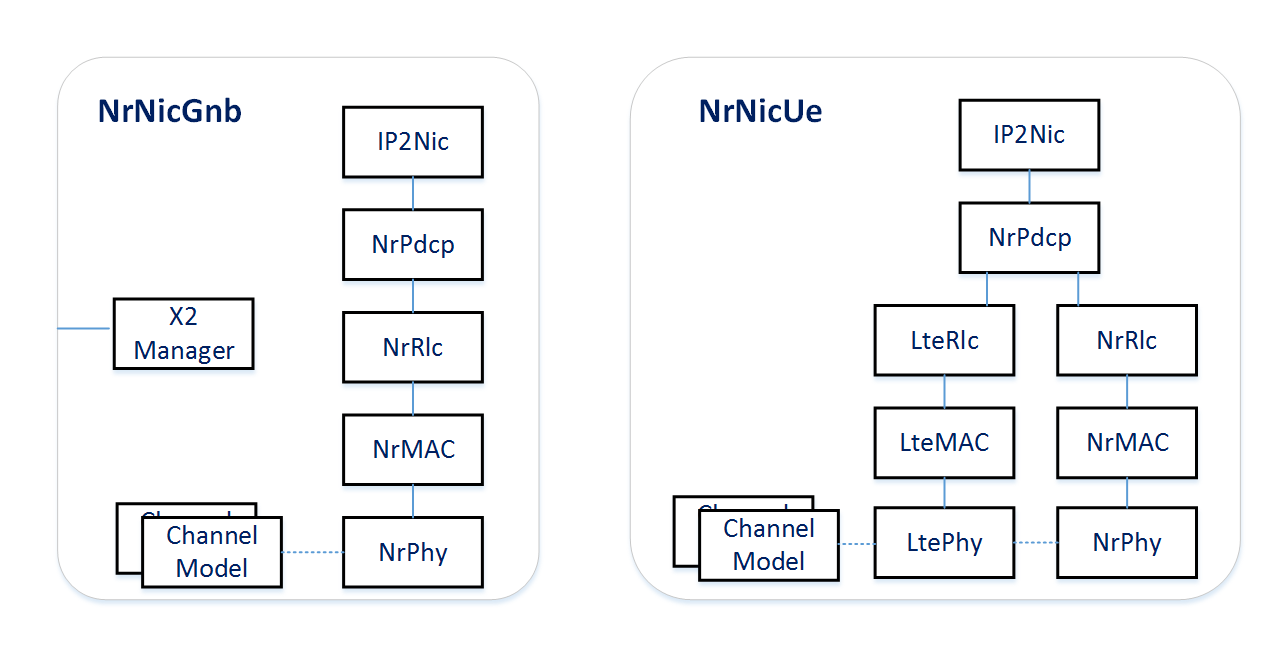
Deployments
Simu5G supports both StandAlone (SA) and E-UTRA/NR Dual Connectivity (ENDC) deployment. where LTE and 5G coexist (3GPP – TR 38.801). In the ENDC configuration, the gNB works as a Secondary Node (SN) for an LTE eNB, which acts as Master Node (MN) and is connected to the Core Network. the LTE eNB model is imported from SimuLTE, with which Simu5G is fully compatible. The eNB and the gNB are connected through the X2 interface and all NR traffic needs to go through the eNB. According to (3GPP - TR 37.340), the data flow between the eNB and the gNB is shown below. Data destined to a UE served by the eNB (Master Cell Group – MCG - bearer) follows the LTE protocol stack, whereas data destined to a UE served by the gNB (Secondary Cell Group – SCG - bearer) gets into the NR PDCP entity at the eNB and is transferred to its peering NR RLC entity in the gNB, via the X2 interface. The 3GPP standard also supports Split Bearers (SBs). With this feature, data belonging to the same connection can traverse either the eNB or the gNB. The PDCP layer at the UE side will then reorder PDUs coming from LTE/NR RLC layers.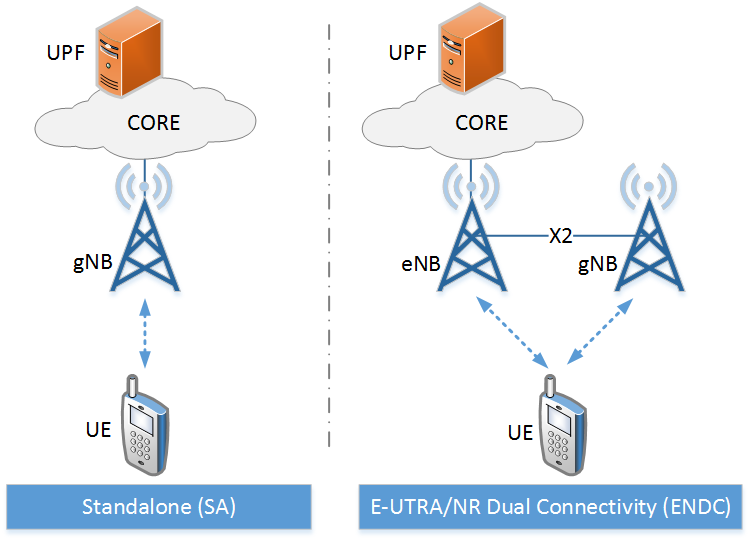
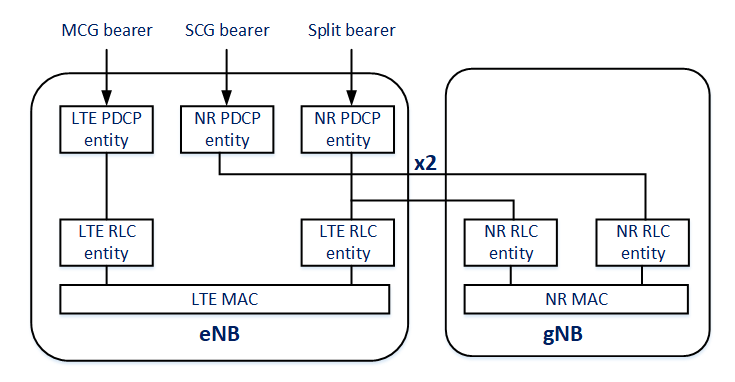
NR resource management
Simu5G currently supports:- Carrier Aggregation (CA): a global carrierAggregation module stores all the information related to the CCs employed in the network. It includes a vector of N ComponentCarrier submodules, whose carrier frequency can be configured via NED/INI. A gNB/UE may be restricted to use only a subset of the available CCs.
- Different numerologies: as with LTE, a NR radio frame is 10 ms long and consists of 10 subframes, each having 1ms duration. However, NR subframes are further divided into up to 14 slots, which are the NR TTIs. A numerology index defines the slot duration, and UEs are scheduled in slots. In Simu5G, a different numerology can be associated to each CC and configured via NED/INI. gNBs and UEs can be limited to only a subset of numerologies.
- Frequency/Time Division Duplexing (FDD/TDD): Simu5G supports both FDD and TDD. In FDD, each CC has separate portions for UL and DL spectra. As far as TDD is concerned, NR foresees 62 possible slot formats (3GPP - TR 38.213), where individual symbols in a slot can be DL, UL or flexible (i.e., it can be assigned dynamically to DL or UL transmissions, or kept idle). We model TDD slot formats as properties of the CC, and we associate the slot format to the componentCarrier submodules. In the current version of Simu5G, flexible symbols are used as guard symbols. However, the above modeling allows one to easily design policies to assign flexible symbols to DL or UL dynamically.
Physical layer modeling
The architecture of the PHY module in Simu5G mirrors the one of SimuLTE, and is shown below.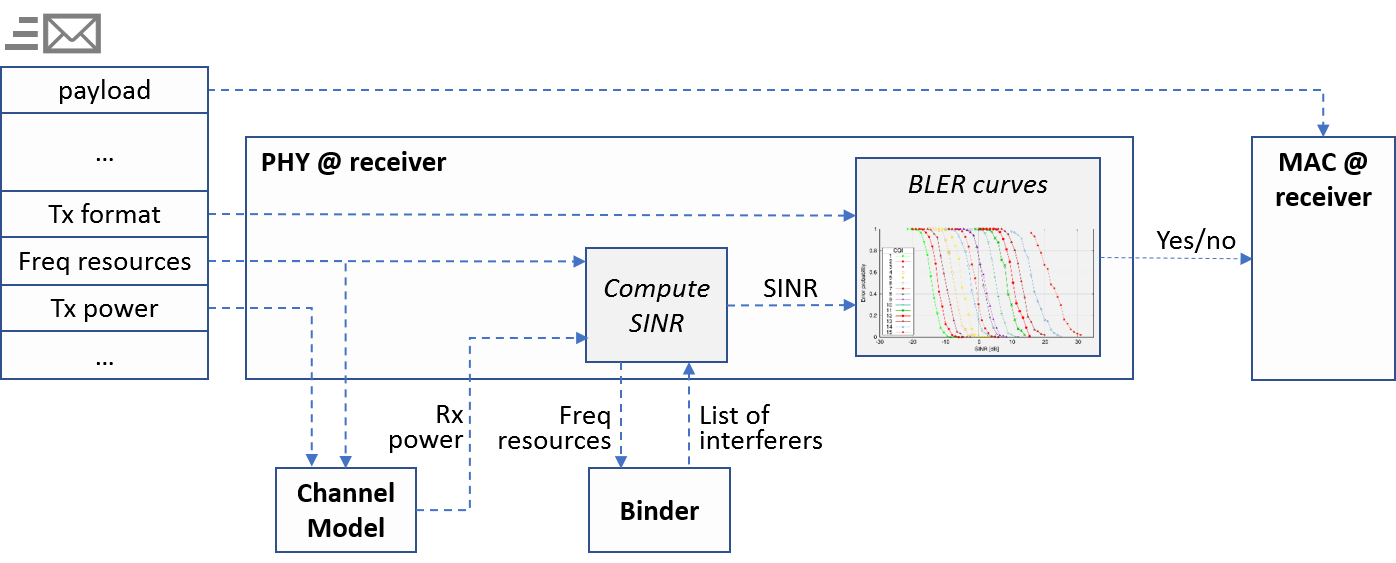 When a MAC PDU is sent from a sender to a receiver, an OMNeT++ message is exchanged between them.
On receipt of the latter, the receiver applies a channel model to compute the received power. The channel model can be configured to incorporate
fading, shadowing, pathloss, etc., and can be made arbitrarily complex. From the received power, the receiver computes the SINR, querying the
Binder to know which other nodes were interfering on the same resources. Then, it leverages Block Error Rate (BLER) curves to compute the reception
probability for each RB composing the ongoing transmission. This makes it possible to translate a SINR and a transmission format to a probability of
correct reception of the entire MAC PDU. The above modelling abates the computational complexity of the decoding operation, hence the simulation
running time, while preserving its correctness.
When a MAC PDU is sent from a sender to a receiver, an OMNeT++ message is exchanged between them.
On receipt of the latter, the receiver applies a channel model to compute the received power. The channel model can be configured to incorporate
fading, shadowing, pathloss, etc., and can be made arbitrarily complex. From the received power, the receiver computes the SINR, querying the
Binder to know which other nodes were interfering on the same resources. Then, it leverages Block Error Rate (BLER) curves to compute the reception
probability for each RB composing the ongoing transmission. This makes it possible to translate a SINR and a transmission format to a probability of
correct reception of the entire MAC PDU. The above modelling abates the computational complexity of the decoding operation, hence the simulation
running time, while preserving its correctness. In Simu5G, each MAC TB is encapsulated within an AirFrame message and sent to the destination module, which applies the model of the air channel to decide whether the AirFrame is received successfully or not. Since a MAC TB is associated with a given CC, the corresponding AirFrame is subjected to channel effects (e.g. path loss, shadowing etc.) that depend on that CC. This means that different channel models have to be applied to compute the SINR at the receiving side. For this reason, each gNB/UE is equipped with a vector of channelModel modules, and each of them is associated with one of the CCs available in the carrierAggregation module.
Simu5G's PHY model has been validated in compliance with the guidelines reported in 3GPP - RP-180524. In particular, in the Urban Macro (UMa) scenario with 57 cells, 30 UEs described in Table 4, config. A of the above document, the SINR distribution obtained with Simu5G matches the reference one perfectly, as shown in the figure below.
